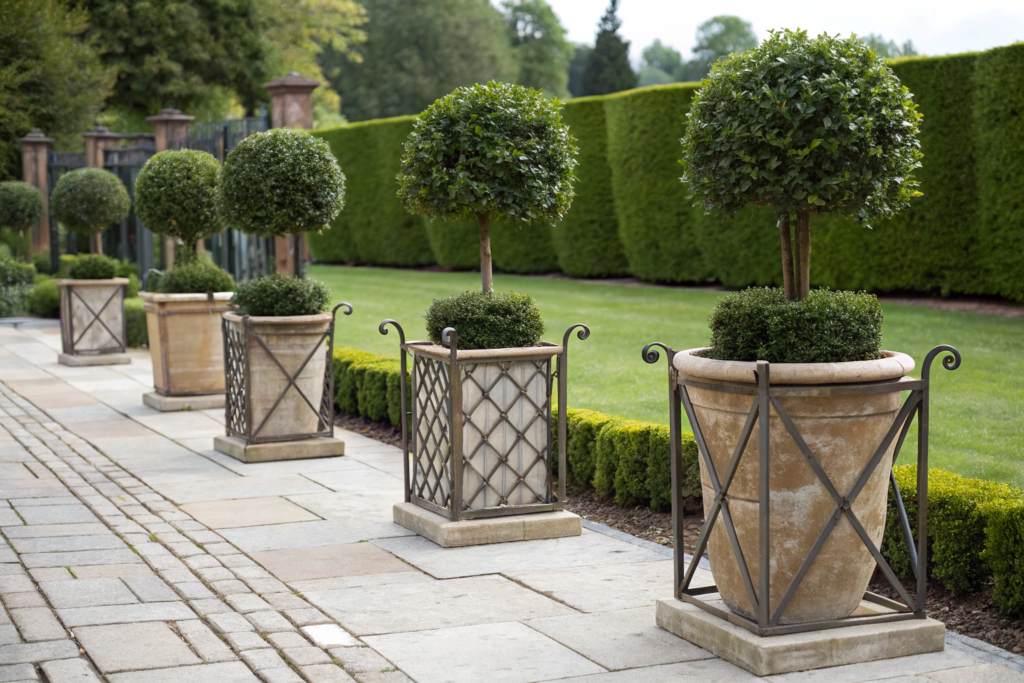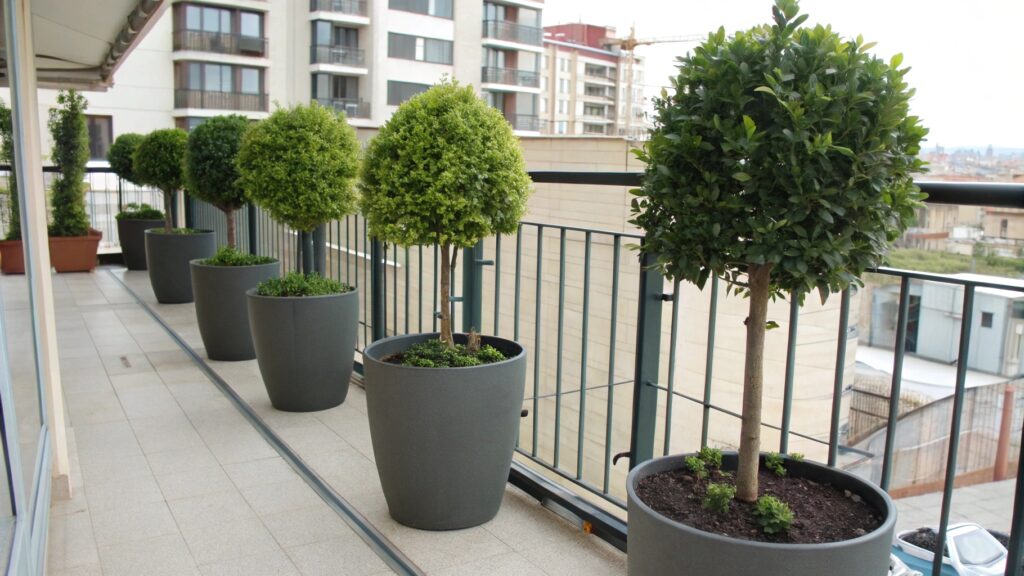Fake plants are a great way to add a touch of greenery to your space without the hassle of upkeep. But unlike real plants, they don’t have roots to keep them grounded, so it’s up to us to make sure they stay in place. By weighing down your faux plants, you not only keep them looking their best but also avoid the frustration of constantly having to fix them. Whether it’s a gust of wind, a curious pet, or a bumpy surface, stability matters. This guide details proven methods to weigh down artificial plants and trees.
Last updated: 3th, June 2025 | Estimated reading time: 7 minutes
Why Weighing Down Fake Plants is Important?
Unlike real plants, which have roots to anchor them down, tall imitation plants need a little extra help to stay upright. Without proper support, they may tip over from things like wind, uneven surfaces, or a curious pet knocking them over. This not only makes them look less realistic but can also be a bit frustrating to deal with.
Weighing down your artificial plants isn’t just about looks—it’s about keeping them safe and steady. A stable plant stays put, making your space feel more polished and realistic. Plus, it prevents any accidents like the pot falling over or a plant constantly toppling every time someone brushes past it. For outdoor spaces, it’s even more important to weigh them down so they don’t get knocked over by the wind, keeping your patio or garden looking neat and tidy.

Materials for Weighing Down Fake Plants: Pros and Cons
Choosing the right material to weigh down your artificial plants is key to keeping them stable and looking natural.If your plant is indoors and in a decorative pot, you might prefer cleaner options like polished river stones which also add an aesthetic touch. For large outdoor planters, concrete offers a permanent, heavy-duty solution. Each option comes with its own set of advantages and drawbacks, so selecting the one that fits your plant’s size, location, and aesthetic is essential.
1. Gravel and Pebbles
Gravel and pebbles are a popular choice because they provide a natural look and offer moderate weight. They’re easy to find and work well for indoor plants or smaller outdoor plants. However, they may not provide enough stability for larger plants or in areas with strong wind.

2. Sand
Sand provides more weight than gravel, making it ideal for medium-sized plants. It can shift over time, especially if the plant is moved, but it’s a solid option for indoor plants or low-wind outdoor areas.
3. Stones or Rocks
Larger stones or rocks offer significant weight and are great for securing large outdoor plants. They add a decorative touch but can be difficult to move once in place.
4. Foam or Styrofoam
Foam or Styrofoam is lightweight and can be a good base layer for smaller plants. It’s often topped with a decorative layer of pebbles or rocks to hide it, though it doesn’t offer much weight for stability.
5. Weighted Pots
Weighted pots come pre-built with extra weight, offering an all-in-one solution for keeping plants stable. These pots are convenient, especially for indoor use, though they may limit design options.

6. Concrete and Cement Mixtures
For maximum stability, especially for large outdoor artificial plants, concrete or cement is the go-to material. Once set, it provides a solid base that’s nearly impossible to tip over, though it is permanent.
Here is a table of the pros and cons of the materials:
| Material | Pros | Cons | Best For |
|---|---|---|---|
| Sand | Inexpensive, fills gaps well, heavy | Can be messy, may compact over time | Most pot sizes, especially irregular shapes |
| Gravel/Pebbles | Good drainage, decorative options | Can be more expensive, less dense than sand | Indoor & outdoor, visible top layer dressing |
| Concrete | Very heavy, permanent solution | Messy to mix, difficult to remove | Large outdoor planters, high wind areas |
| Stones/Rocks | Decorative, heavy, various sizes | Can be costly, may not fill all gaps evenly | Top dressing, larger pots needing significant weight |
| Expanding Foam | Secures plant stem, adds some stability | Less about weight, more about fixing in place | Securing stems before adding heavier materials |
Step-by-Step Process for Weighing Down Artificial Plants
Weighing down your artificial plants properly ensures they remain stable, whether indoors or outdoors. A well-secured faux plant not only looks more realistic but also stays upright in the face of wind, movement, or accidental bumps. Below is a step-by-step guide to help you keep your plants in place and looking their best.
1. Gather Your Materials
- Start by collecting everything you need:
- The artificial plant
- A clean planter or pot
- Your chosen weighting material (e.g., gravel, sand, foam, concrete, or rocks)
- Optional fillers like moss or glass beads for decorative purposes
Start with a clean, dry container that’s proportional to your artificial plant’s size. For optimal stability, choose a pot with a wide base relative to its height—ideally with a bottom width at least one-third of the total height of the plant and container combined.
It’s essential to pick the right material based on the plant’s size and where it will be placed. Heavier materials like rocks or concrete are better suited for outdoor plants, while lighter options like pebbles or foam work well indoors.
2. Arrange Your Artificial Plant
Before adding any weight, place your artificial plant into the container, nestling the stem or trunk into the weighting material. Adjust the position until the plant sits at the desired height. Make sure it sits as you want it to look once secured. For taller plants, you can consider attaching the stem to a dowel or stake before positioning for additional support. Some people choose to glue their plant to a sturdy base like a flat iron plate for extra stability. This can be particularly helpful for larger or top-heavy plants.

3. Add a Base Layer of Weight
Begin by adding your chosen weighting material to the bottom of the pot. This creates a stable base for the plant. Depending on the material:
For gravel, sand, or rocks, make sure the base layer is packed snugly.
For concrete or cement mixtures, mix and pour carefully, ensuring an even spread before it sets.
The goal is to make sure the plant won’t shift once it’s in place.
4. Secure the Plant in Place
Nestle the base of your artificial plant into the weighted material. Make sure it is centered and stable:
For cement or foam, let the material set before moving on to the next step.
For lighter materials like pebbles or sand, gently pack them around the plant’s base to ensure it stays upright.
5. Test for Stability
Once you have positioned the plant, give the pot a slight nudge. If it wobbles or feels unsteady, adjust the weight or positioning as needed. For larger plants, you may need to add additional layers of weight to ensure it’s secure.
6. Add Decorative Filler
Now that the plant is stable, it’s time for the finishing touches. You can add a decorative top layer, such as:
- Moss for a natural look
- Glass beads for a more polished appearance
- Additional artificial foliage to blend with the plant

This top layer serves both an aesthetic and functional purpose by further securing the plant and hiding the weight materials.
7. Final Adjustments
Check once more to ensure the plant is securely anchored. If everything feels stable, your artificial plant is ready to be displayed. Make any final adjustments to the appearance to ensure the plant looks natural and fits the design of the space.
Best Weighing Methods for Indoor vs. Outdoor Artificial Plants
The environment where you place your artificial plants directly determines which stability method will work best. Indoor settings face minimal movement disturbances, while outdoor locations must contend with wind, rain, and temperature fluctuations. Using the right stabilizing approach for each setting ensures your faux greenery stays perfectly positioned regardless of conditions.
Different environments demand different solutions—what works perfectly for your living room might fail completely on your patio. Outdoor artificial plants require 2-3 times more weight for proper stabilization compared to their indoor counterparts due to environmental factors. When securing outdoor artificial plants, be sure to account for weather conditions. Cement or heavier rocks work best for outdoor plants, ensuring they won’t tip over in strong winds. Additionally, drainage is important to prevent water accumulation, as stagnant water can damage the planter and make the plant unstable.
Indoor Faux Plants Stability Solutions
For indoor artificial plants, aesthetic considerations typically take priority over extreme durability. Since these plants won’t face harsh elements, you can focus on solutions that look attractive while providing just enough weight to prevent tipping.
- Decorative Stones or Glass Beads: Perfect for visible planters, these add both weight and visual appeal. Place them as a top layer for a finished look in glass or transparent containers.
- Lightweight Foam with Sand Mixture: For closed planters, this provides adequate stability without excessive weight that might damage furniture surfaces.
- Silicone Adhesives: Ideal for securing plants to decorative containers in high-traffic areas where they might be bumped.

Outdoor Artificial Plants Stability Solutions
Outdoor artificial plants require robust stabilization methods to withstand environmental challenges. Wind resistance becomes your primary concern, followed by protection against heavy rain and temperature fluctuations.
- Concrete or Cement Bases: Creates permanent weight that won’t shift or degrade. Adding 1-2 inches at the planter base provides excellent stability for tall outdoor plants.
- Expandable Foam with Heavy Gravel: This combination fills planter spaces completely while adding substantial weight. The foam also provides insulation against temperature changes.
- Steel Base Plates with Anchoring Systems: For extremely windy locations, steel plates (¼ inch thick) secured to planters can be further anchored to decking or patio surfaces.
- Weather-Resistant Sand Bags: These can be discretely placed inside large planters, providing 10-15 pounds of weight while allowing for drainage.

Safety First in Artificial Plant Setups
Before you even begin, it’s vital to think about safety. An unsecured tall artificial plant, especially on a balcony or in a busy area, is more than just an inconvenience if it falls—it’s a genuine hazard. Your primary goal when you weigh down artificial plants is to protect your family, pets, and visitors. For business owners, ensuring plant stability is a crucial part of your public liability and duty of care, preventing accidents in your shop, restaurant, or office space.
Safety also extends to your choice of materials and placement. If you are placing plants indoors in a commercial setting, always check if you need fire-retardant foliage to comply with UK building and safety regulations. Furthermore, never place large planters where they could obstruct fire exits, narrow walkways, or essential access points. Following these safety principles ensures your beautiful green installation is also completely safe, responsible, and compliant, giving you total peace of mind.
Unique Methods for Securing Fake Plants
In addition to traditional materials like pebbles or cement, there are several creative methods you can use to secure artificial plants. These techniques offer flexibility, especially for indoor plants, and can be tailored to fit your specific needs.

1. DIY Hidden Supports
For large or top-heavy artificial plants, hidden supports such as rods or dowels can be placed inside the planter to provide extra stability. These can be easily disguised with decorative fillers like moss or artificial soil, ensuring they remain unseen while giving the plant a firm foundation.
2. Flexible Pot Inserts
Flexible pot inserts are an excellent option for stabilizing smaller or medium-sized plants. These inserts snugly fit into the planter, holding the plant in place without adding too much weight. They are particularly useful for indoor plants where heavy materials aren’t needed.
3. Weighted Soil Alternatives
If you’re looking for a solution that mimics real soil but adds weight, consider using weighted soil alternatives like clay-based fillers or heavy foam. These materials not only stabilize the plant but also give a more natural appearance.
4. Adhesive Techniques for Indoors
For small or lightweight plants, adhesive pads or strips can be used to secure the planter to a flat surface. This method prevents accidental tipping and is a discreet solution, especially for plants placed on shelves or tables.

Tips for Maintaining Faux Plant Stability and Longevity
Ensuring your artificial plants remain stable and durable requires some ongoing attention, especially for outdoor settings. Below are expert tips to help maintain both the stability and longevity of your faux plants.
1. Seasonal Adjustments for Outdoor Plants
Outdoor artificial plants are exposed to various weather conditions. During windy or stormy seasons, it’s essential to check the weight and stability of your plants. Consider adding extra support or moving them to sheltered areas during harsh weather. Periodic adjustments to the base weight, such as adding more rocks or heavier materials, can prevent toppling in strong winds.

2. Using UV-Resistant Materials for Added Longevity
Sun exposure can cause artificial plants to fade or become brittle over time. Using UV-resistant materials ensures your plants maintain their vibrant color and durability, especially in outdoor settings. These materials are designed to withstand harsh sunlight, prolonging the life of your faux greenery.
3. Creative Hacks for Achieving a Natural Look While Ensuring Stability
To blend aesthetics with stability, you can use creative fillers like moss, decorative stones, or artificial soil to hide the weighted base. These materials not only provide added weight but also help your plants look more natural. Using weighted pots or containers that match the décor ensures that your plants stay stable without compromising on style.
Weighing down artificial plants is key to ensuring they remain stable and maintain their realistic appearance. Whether indoors or outdoors, choosing the right method—based on the plant’s size, location, and aesthetic—will keep them secure.
Making Your Weighted Plants Look Naturally Beautiful:
Transform your weighted artificial plants into attractive displays with these professional techniques:
- Implement strategic layering: Position stabilizing weights at the container base (such as sand or cement), add transitional medium materials in the middle zone (like gravel or small pebbles), and finish with decorative elements at the visible surface level (preserved moss or decorative mulch)
- Apply biophilic topping materials: Distribute premium preserved moss, or polished river stones across the surface with natural variation in pattern and density—for example, placing larger pieces toward the edges and finer materials near the plant stem
- Enhance perimeter plantings: Incorporate small artificial ferns, or succulent pieces around the plant base to simulate natural companion growth—just as you’d see smaller plants clustered around a tree trunk in nature
- Utilize texture contrasts: Combine smooth polished stones with rough bark chips, or glossy preserved leaves with matte-finished dried botanicals to create visual depth similar to natural forest floor environments
- Incorporate seasonal accents: Integrate small seasonal botanical elements appropriate to your region’s natural growth cycles to enhance authenticity and visual interest

About FeelReal Artificial Plants
At FeelReal, we specialize in premium artificial plants designed with both aesthetics and practicality in mind. Our products feature integrated stability solutions, UV-resistant materials, and realistic appearances that stand the test of time. From tabletop arrangements to statement floor plants, we offer solutions for every space and style preference.
Need expert advice on artificial plants? Our design consultants are available to provide personalized recommendations for your specific needs.


